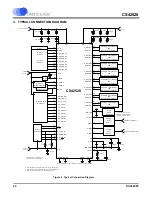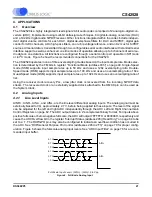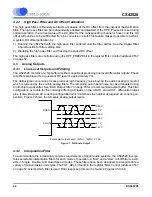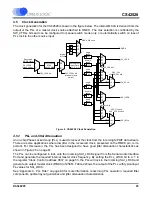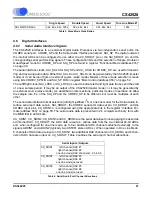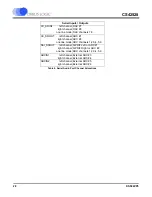
CS42528
14
DS586PP5
SWITCHING CHARACTERISTICS - CONTROL PORT - SPI
TM
FORMAT
(For CQZ, T
A
= -10 to +70° C; For DQZ, T
A
= -40 to +85° C; VA=VARX = 5 V, VD =VLS= 3.3 V; VLC = 1.8 V to
5.25 V; Inputs: Logic 0 = DGND, Logic 1 = VLC, C
L
= 30 pF)
Notes: 19. If Fs is lower than 46.875 kHz, the maximum CCLK frequency should be less than 128 Fs. This is
dictated by the timing requirements necessary to access the Channel Status and User Bit buffer
memory. Access to the control register file can be carried out at the full 6 MHz rate. The minimum
allowable input sample rate is 8 kHz, so choosing CCLK to be less than or equal to 1.024 MHz should
be safe for all possible conditions.
20. Data must be held for sufficient time to bridge the transition time of CCLK.
21. For f
sck
<1 MHz.
Parameter
Symbol Min Typ
Max
Units
CCLK Clock Frequency
(Note 19)
f
sck
0
-
6.0
MHz
CS High Time Between Transmissions
t
csh
1.0
-
-
µ
s
CS Falling to CCLK Edge
t
css
20
-
-
ns
CCLK Low Time
t
scl
66
-
-
ns
CCLK High Time
t
sch
66
-
-
ns
CDIN to CCLK Rising Setup Time
t
dsu
40
-
-
ns
CCLK Rising to DATA Hold Time
(Note 20)
t
dh
15
-
-
ns
CCLK Falling to CDOUT Stable
t
pd
-
-
50
ns
Rise Time of CDOUT
t
r1
-
-
25
ns
Fall Time of CDOUT
t
f1
-
-
25
ns
Rise Time of CCLK and CDIN
(Note 21)
t
r2
-
-
100
ns
Fall Time of CCLK and CDIN
(Note 21)
t
f2
-
-
100
ns
t r2
t f2
t dsu
t dh
t sch
t scl
CS
CCLK
CDIN
t css
t pd
CDOUT
t csh
Figure 4. Control Port Timing - SPI Format




















